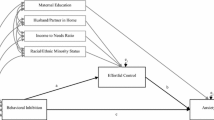Abstract
Stability of inhibited/uninhibited temperament was assessed using 1,795 Mauritian children tested at ages 3, 8, and 11 years. Children were divided into uninhibited, middle, and inhibited groups at each age based on social behavior. Results indicated that, relative to uninhibited children (1) those inhibited at age 3 obtained larger inhibition scores at age 8 (p< .0001), (2) those inhibited at age 8 obtained larger inhibition scores at age 11 (p< .002), and (3) those remaining inhibited from ages 3 to 8 obtained larger inhibition scores at age 11 (p< .002). Relative to children who changed classification from ages 3 to 8, those remaining inhibited obtained larger inhibition scores (p< .05) and those remaining uninhibited obtained smaller inhibition scores (p< .015) at age 11. Inhibition scores tended to be higher in females by age 11. Results remained regardless of ethnicity. The results provide some support that inhibited/uninhibited temperament remains stable from ages 3 to 8 and may continue to age 11. The results suggest cross-cultural generalizability of these findings with implications regarding the development of anxiety disorders in the Mauritian population.
Similar content being viewed by others
References
Achenbach, T. M., & Edelbrock, C. S. (1978). The classification of childhood psychopathology: A review and analysis of empirical efforts.Psychological Bulletin, 85, 1275–1301.
Biederman, J., Rosenbaum, J. F., Bolduc-Murphy, E. A., Faraone, S. V., Chaloff, J., Hirshfeld, D. R., & Kagan, J. (1993). A 3-year follow-up of children with and without behavioral inhibition.Journal of the American Academy of Child and Adolescent Psychiatry, 32, 814–821.
Biederman, J., Rosenbaum, J. F., Hirshfeld, D. R., Faraone, S. V. (1990). Psychiatric correlates of behavioral inhibition in young children of parents with and without psychiatric disorders.Archives of General Psychiatry, 47, 21–26.
Broberg, A., Lamb, M. E., & Hwang, P. (1990). Inhibition: Its stability and correlates in sixteen- to forty-month-old children.Child Development, 61, 1153–1163.
Garcia-Coll, C., Kagan, J., & Reznick, J. S. (1984). Behavioral inhibition in young children.Child Development, 55, 1005–1019.
Hirshfeld, D. R., Rosenbaum, J. F., Biederman, J., & Bolduc, E. A. (1992). Stable inhibition and its association with anxiety disorder.Journal of the American Academy of Child and Adolescent Psychiatry, 31, 103–111.
Kagan, J. (1989). Temperamental contributions to social behavior.American Psychologist, 44, 668–674.
Kagan, J., Reznick, J. S., Clarke, C., Snidman, N., & Garcia-Coll, C. (1984). Behavioral inhibition to the unfamiliar.Child Development, 55, 2212–2225.
Kagan, J., Reznick, J. S., & Gibbons, J. (1989). Inhibited and uninhibited types of children.Child Development, 60, 838–845.
Kagan, J., Reznick, J. S., & Snidman, N. (1987). The physiology and psychology of behavioral inhibition.Child Development, 58, 1459–1473.
Kagan, J., Reznick, J. S., & Snidman, N. (1988). Biological bases of childhood shyness.Science, 240, 167–171.
Kagan, J., Reznick, J. S., Snidman, N., & Gibbons, J. (1988). Childhood derivatives of inhibition and lack of inhibition to the unfamiliar.Child Development, 59, 1580–1589.
Kagan, J., & Snidman, N. (1991). Temperamental factors in human development.American Psychologist, 46, 856–862.
Kochanska, G., & Radke-Yarrow, M. (1992). Inhibition in toddlerhood and the dynamics of the child's interaction with an unfamiliar peer at age 5.Child Development, 63, 325–335.
Matheny, A. P. (1989). Children's behavioral inhibition over age and across situations: genetic similarity for a trait during change.Journal of Personality, 57, 215–235.
Mullen, B., & Miller, N. (1991). Meta-analysis. In C. M. Judd, E. R. Smith, & L. H. Kidder (Eds.),Research methods in social relations (6th ed., pp. 425–449). Fort Worth: Holt, Rinehart and Winston.
Quay, H. C., & Werry, J. S. (Eds.). (1979).Psychopathological disorders of childhood (2nd ed.). New York: Wiley.
Reznick, J. S., Kagan, J., Snidman, N., Gersten, M., Baak, K., & Rosenberg, A. (1986). Inhibited and uninhibited children: A follow-up study.Child Development, 57, 660–680.
Rosenbaum, J. F., Biederman, J., Gersten, M., & Hirshfeld, D. R. (1988). Behavioral inhibition in children of parents with panic disorder and agoraphobia: A controlled study.Archives of General Psychiatry, 45, 463–470.
Rosenbaum, J. F., Biederman, J., Hirshfeld, D. R., & Bolduc, E. A. (1991). Further evidence of an association between behavioral inhibition and anxiety disorders: Results from a family study of children from a non-clinical sample.Journal of Psychiatric Research, 25, 49–65.
Rosenthal, R. (1986). Media violence, antisocial behavior, and the social consequences of small effects.Journal of Social Issues, 42, 141–154.
Rutter, M. (1967). A children's behavior questionnaire for completion by teachers: Preliminary findings.Journal of Child Psychology and Psychiatry, 8, 1–11.
Venables, P. H., Fletcher, R. P., Dalais, J. C., Mitchell, D. A., Schulsinger, F., & Mednick, S. A. (1983). Factor structure of the Rutter ‘Children's Behavior Questionnaire’ in a primary school population in a developing country.Journal of Child Psychology and Psychiatry, 24, 213–222.
Venables, P. H., Mednick, S. A., Schulsinger, F., Raman, A. C., Bell, B., Dalais, J. C., & Fletcher, R. P. (1978). Screening for risk of mental illness. In G. Serban (Ed.),Cognitive defects in the development of mental illness (pp. 273–303). New York: Brunner/Mazel.
Author information
Authors and Affiliations
Additional information
The efforts of Cyril Dalais, Brian Bell, Athenea Chiriaca, and all the local members of the longitudinal study, the Mauritius Joint Child Health Project, are gratefully acknowledged. We are also especially thankful to Drs. Michael E. Dawson, David Walsh, and Bill McClure for their helpful comments and suggestions.
The data used in this study were collected while the project was supported by the Medical Research Council (UK), the Wellcome Trust (UK), and the Mauritian government. The data were analyzed and findings written as part of the first author's dissertation work under the support of the NIMH Pre-doctoral Individual National Research Service Award and a USC Dissertation Fellowship Award.
Rights and permissions
About this article
Cite this article
Scarpa, A., Raine, A., Venables, P.H. et al. The stability of inhibited/uninhibited temperament from ages 3 to 11 years in mauritian children. J Abnorm Child Psychol 23, 607–618 (1995). https://doi.org/10.1007/BF01447665
Received:
Issue Date:
DOI: https://doi.org/10.1007/BF01447665




